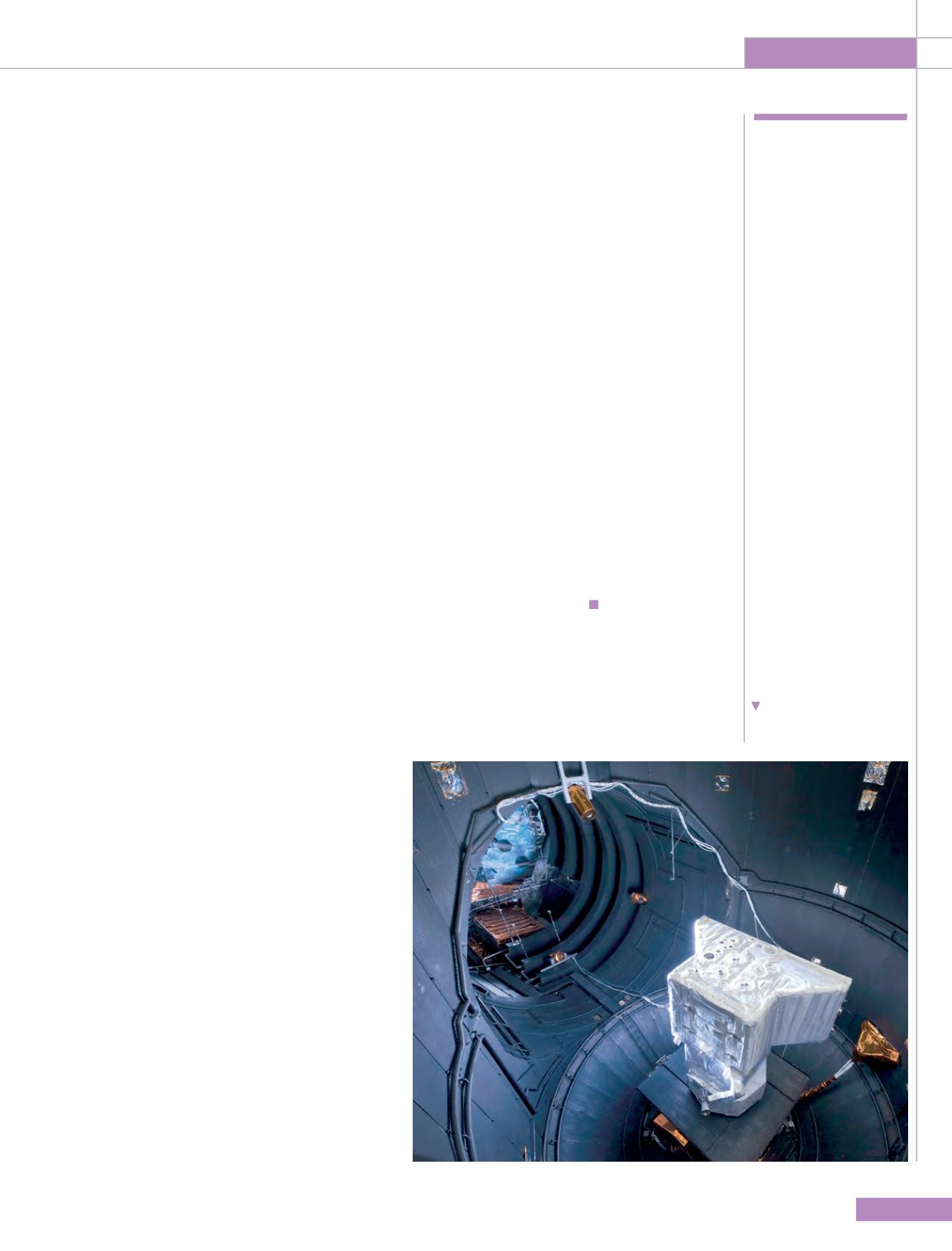
ROOM
87
Space Science
the Italian branch of Thales Alenia Space in charge
of the crucial thermal control subsystem.
The harsh thermal environment that
BepiColombo is going to face has posed
unprecedented technical challenges; not only was
it necessary to develop and test new materials able
to withstand the extreme environments of space,
including severe temperatures, and to insulate the
spacecraft with utmost efficiency, but ESA also had
to extensively refurbish its test facility, the Large
Space Simulator (LSS). This was a necessary part
of the process in order to increase the LSS’s solar
simulation capability from 1300 W/m
2
(the solar
flux around Earth) to more than 10,000 W/m
2
, a
target achieved with a set of expensive and fragile
lamps of 25 kW each – power that would have any
commercial electricity supplier rubbing their hands
with glee if they had to supply it.
Aside from the mechanical challenges, it was
necessary to coordinate teams of scientists and
engineers from all over Europe to coordinate the
various payloads aboard MPO and to satisfy their
often conflicting technical needs.
Not only that, but new design solutions also had
to be developed. For instance, a normal spacecraft
has a stack of thermal blankets all around it to
protect it from the environment; MPO has three
carefully designed stacks on top of each other,
which are partly composed of materials developed
ad hoc and are able to withstand temperatures of
up to 400C.
In addition, it is normal for one or two sides of a
spacecraft to always be in shadow, thus allowing these
sides to act as radiators, to dissipate heat coming from
both the Sun and onboard electronics in the spacecraft
itself, into deep space. In the case of the MPO, however,
all sides of the spacecraft will receive significant
amounts of heat flux from either the Sun of Mercury. It
was therefore necessary to devise an intricate design of
curvedmirrors that will discard heat generated by the
spacecraft, while simultaneously deflecting the heat
coming from the planet.
Onwards and upwards
Although many issues have been successfully
resolved, several unexpected problems arose when
the manufacturing was already at an advanced
stage. These of course have needed workaround
solutions that have caused delays and put at risk
the scientific significance of the mission.
Nonetheless, the team has managed to get on
top of all the obstacles faced and it is with a great
amount of satisfaction that we are on our way to
achieve what will be an historical result for the
European space industry.
Having a dual
spacecraft
such as MPO
and MMO has
the advantage
of being able
to study two
regions of the
planet at the
same time
The integration and testing of the various
modules is being completed and the launch of
BepiColombo on an Ariane 5 rocket is currently
scheduled for 2018. After a six-year cruise, that
will see the spacecraft fly by Venus twice and
Mercury six times before it settles into the right
orbit, BepiColombo will resume the exploration of
Mercury, taking over where MESSENGER left off.
Once in orbit and using the Usuda 64 m antenna
in Japan, the ISAS/JAXA Sagamihara Space
Operation Centre, will take over the operation of
the MMO. Similarly, the European Space Operations
Centre (ESOC) in Darmstadt, Germany, will remain
in charge of the MPO spacecraft.
During its one Earth year mission, which
equates to four Mercury years, it is hoped that
BepiColombo will answer some fundamental
questions such as: is Mercury tectonically
active today? Is its core liquid or solid? Why
do spectroscopic observations of Mercury
not reveal the presence of any iron, when this
element is expected to be the planet’s major
constituent? These are just a few of the 12
scientific objectives that BepiColombo is hoping
to answer, while helping to understand what
makes Mercury so special.
About the author
Andrea Ferrero is a specialist in thermal verification at Thales Alenia
Space Italia in Turin, Italy, where, since 1997, he has worked on modules
of the International Space Station and on several Earth observation
satellites. He is a thermal systems engineer for BepiColombo, and is
also among the organisers of the annual International Conference on
Environmental Systems.
BepiColombo’s MPO
antenna in the Large
Space Simulator (LSS).
ESA


